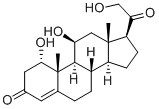1alpha-Hydroxycorticosterone
- CAS No.
- 10163-49-2
- Chemical Name:
- 1alpha-Hydroxycorticosterone
- Synonyms
- 4-PREGNEN-1α, 11β, 21-TRIOL-3, 20-DIONE;Pregn-4-ene-3,20-dione, 1,11,21-trihydroxy-, (1α,11β)-
- CBNumber:
- CB81118216
- Molecular Formula:
- C21H30O5
- Molecular Weight:
- 362.46
- MDL Number:
- MFCD03695658
- MOL File:
- 10163-49-2.mol
1alpha-Hydroxycorticosterone price
| Manufacturer | Product number | Product description | CAS number | Packaging | Price | Updated | Buy |
|---|---|---|---|---|---|---|---|
| American Custom Chemicals Corporation | SHG0000912 | 1-ALPHA-HYDROXYCORTICOSTERONE 98.00% | 10163-49-2 | 10MG | $1201.2 | 2021-12-16 | Buy |
| American Custom Chemicals Corporation | SHG0000912 | 1-ALPHA-HYDROXYCORTICOSTERONE 98.00% | 10163-49-2 | 0.1G | $1746.8 | 2021-12-16 | Buy |
1alpha-Hydroxycorticosterone Chemical Properties,Uses,Production
Description
1α-hydroxycorticosterone is a physiologically important corticosteroid synthesized only in elasmobranchs. 1α- hydroxycorticosterone is synthesized in the interrenal gland in copious amounts relative to other endogenous steroids. The 1α-hydroxylation of corticosterone has been detected in the steroidogenic tissues of the elasmobranch, but the underlying gene has not been identified.
Discovery
In 1966, a novel corticosteroid, 1α,11β,21-trihydroxypregnen-4-ene-3,20-dione, was isolated from the plasma of two species of rays, and this steroid was later confirmed to be 1α-hydroxycorticosterone.Further research revealed that 1α-hydroxycorticosterone was the dominant corticosteroid produced by the interrenal tissue in the elasmobranch.In 1972, 1α- hydroxycorticosterone was synthesized biochemically and a sensitive radioimmunoassay (RIA) was developed that allowed the measurement of the steroid from significantly smaller volumes of plasma.
Physiological actions
1α-hydroxycorticosterone has a mineralocorticoidlike role in the regulation of salt and osmolyte balance. The administration of 1α-hydroxycorticosterone into rats produced significant sodium retention, and it has been shown to stimulate sodium transport across the isolated toad bladder. The increase in plasma sodium is correlated with a significant increase in plasma 1α-hydroxycorticosterone concentration, suggesting that 1α-hydroxycorticosterone possesses a mineralocorticoid role in renal function. A mineralocorticoid function of 1α-hydroxycorticosterone in the elasmobranch has been demonstrated in key tissues involved in osmoregulation such as the gill, kidney, and rectal gland of the skate.The evidence for 1α-hydroxycorticosterone’s glucocorticoid-like effects is speculative. ACTH clearly influences corticosteroidogenesis in the elasmobranch, implying that 1α-hydroxycorticosterone is the principle glucocorticoid in the elasmobranch. However, there is no evidence of the direct actions of 1α- hydroxycorticosterone on the glucose metabolism in the elasmobranch. Salinity transfer studies showed an increase in the circulating levels of 1α-hydroxycorticosterone, but there is a need for the definitive measurement of 1α-hydroxycorticosterone in the plasma of the elasmobranch following a stressful event.
Regulation of synthesis and release
Many genes encoding steroidogenic enzymes have been identifiedin the elasmobranch;however, a few key enzymes are unidentified, including 1α-hydroxylase and CYP11B, which catalyze the conversion of 11-deoxycorticosterone to 1α-hydroxycorticosterone.In mammals, the major mineralocorticoid is aldosterone; however, fish do not synthesize aldosterone.4, 5 Corticosteroids may play dual roles regulating both mineralocorticoid and glucocorticoid responses in fish. The glucocorticoid response in fish is triggered by the release of the corticotrophin-releasing hormone (CRH) in the hypothalamus. In fact, the injection of CRH induced an increase in the circulating levels of 1α- hydroxycorticosterone in the dogfish. Further, the adrenocorticotropic hormone (ACTH) has been shown to stimulate 1α-hydroxycorticosterone production both in vitro and in vivo.
Mechanisms of actions
The molecular basis for 1α-hydroxycorticosterone action in the elasmobranch, particularly its potential interactions with the mineralocorticoid receptor (MR) and glucocorticoid receptor (GR), remains unclear. Carroll et al.showed that using an in vitro reporter gene assay, MR serves as a high-sensitivity receptor and GR as a lowsensitivity receptor. Elasmobranch MR is a high-sensitivity receptor that responds to low nanomolar concentrations of 1α-hydroxycorticosterone and other corticosteroids,while concentrations that were 2–4 orders of higher magnitude were needed to achieve the half-maximal activation of GR. Endogenous concentrations of 1α-hydroxycorticosterone in the elasmobranch are expected to activate the MR.
1alpha-Hydroxycorticosterone Preparation Products And Raw materials
Raw materials
Preparation Products
1alpha-Hydroxycorticosterone Suppliers
| Supplier | Tel | Country | ProdList | Advantage | |
|---|---|---|---|---|---|
| Shanghai Saikerui Biotechnology Co. , Ltd. | 021-58000709 15900491054 | info@scrbio.com | China | 9260 | 58 |
| Supplier | Advantage |
|---|---|
| Shanghai Saikerui Biotechnology Co. , Ltd. | 58 |





